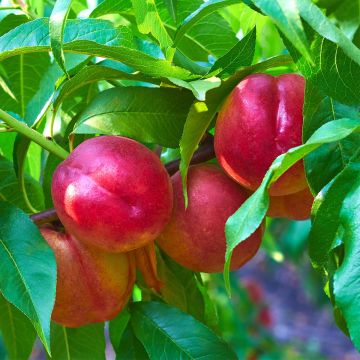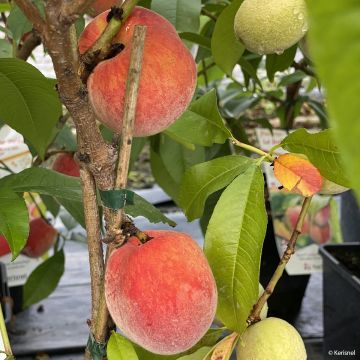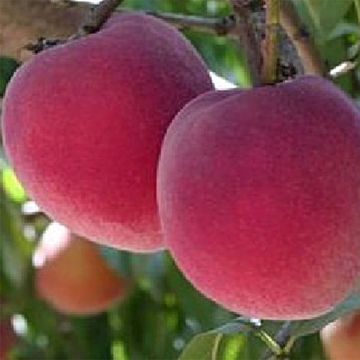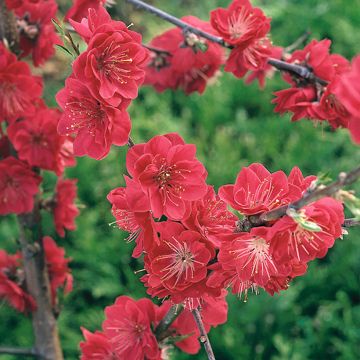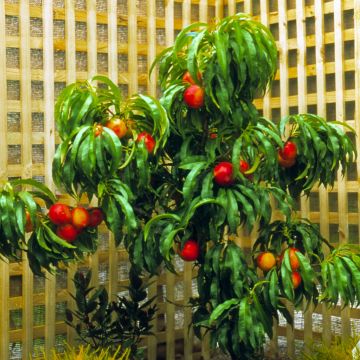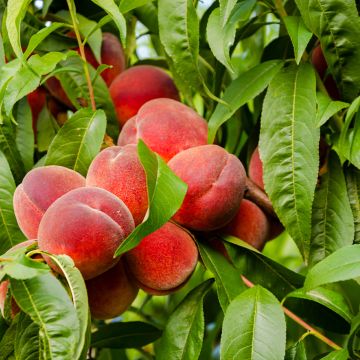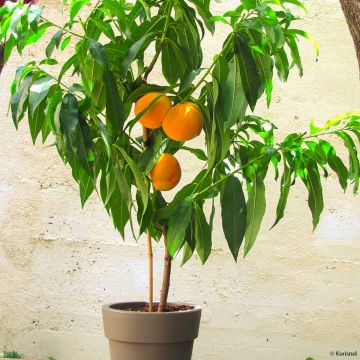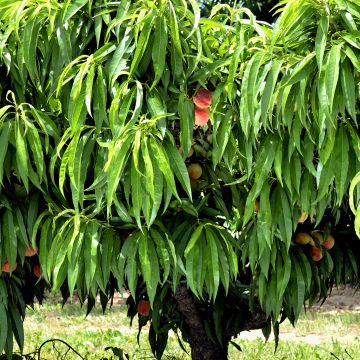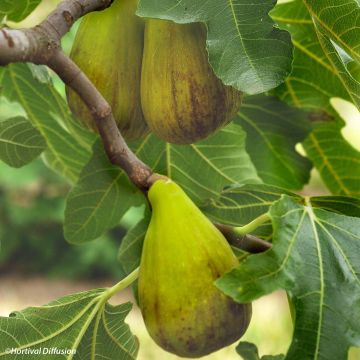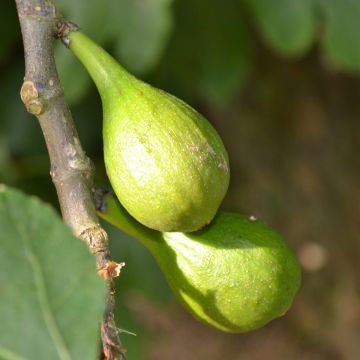

Nectarinier Honey Muscat®
Prunus persica Honey Muscat - Nectarine Tree
Prunus persica Honey Muscat®
Peach, Peach tree
Très satisfait, très bons fruits, juteux et savoureux
Jean-Claude, 29/04/2022
Why not try an alternative variety in stock?
View all →This plant carries a 6 months recovery warranty
More information
We guarantee the quality of our plants for a full growing cycle, and will replace at our expense any plant that fails to recover under normal climatic and planting conditions.
Oversize package: home delivery by special carrier from €6.90 per order..
Express home delivery from €8.90.
Delivery to Corse prohibited: UE law prohibits the import of this plant from mainland France to Corse as part of the fight against Xylella fastidiosa. Please accept our sincere apologies.
More information

Description
Prunus persica Honey Muscat is a highly productive self-fertile variety. Its yellow-fleshed nectarines are about 6cm (3in) in diameter. The dark red round fruits are sweet, delicious, and juicy. Harvest when the fruits are ripe, from 20th July or later, depending on the region.
Prunus persica was believed to originate from Persia, hence the species name "persica". In reality, all cultivated forms originate from northern China. The nectarine tree is the result of a natural mutation of the peach tree that occurred in the 16th century. Honey Muscat is a recent variety that is an American mutation of the original Asian peach tree, obtained in the USA by ZAIGER GENETICS in California.
Like many fruit trees, Honey Muscat appreciates light, rich, and deep soils. It does not tolerate excess water or heavy and compact soils. It is quite vigorous. Its upright habit forms a tall trunk tree with many branches that grow vertically, giving it a slender appearance. Its deciduous foliage is bright green and has a slight almond scent. Its leaves are long, 8 to 15cm (3 to 6in) in length and 3 to 4cm (1 to 2in) in width, with short petioles.
Its pink flowering occurs in March. It should be grown in a sunny location, protected from wind. The flowers are hermaphrodite and self-fertile.
The fruiting results in dark red fruits, ready to be harvested from mid-July. This tree does not require too much maintenance. It can withstand severe pruning, but not every year.
Nectarines can be enjoyed raw, cooked, flambéed, glazed, or deglazed. They work well in both sweet and savoury dishes. They pair well with wine and certain meats, such as duck. They can be found in numerous recipes, including jams, compotes, and pastries.
For transportation reasons, our tallest scions may be pruned before shipment. They are suitable for all common training sizes: cordons, espaliers, goblets, half-standards, and low standards, except for the formation of tall standards. If you would like more information or advice on the training of your fruit trees, please do not hesitate to contact us.
Report an error about the product description
Prunus persica Honey Muscat - Nectarine Tree in pictures




Plant habit
Fruit
Flowering
Foliage
Botanical data
Prunus
persica
Honey Muscat®
Rosaceae
Peach, Peach tree
Cultivar or hybrid
Franc (Bare root - Scion)
Other Peach and Nectarine trees
Planting and care
Ideally, plant from September to November. Dig a hole two to three weeks before planting, twice as wide and deep as the pot. On the day, place the tree with its pot in a basin of water to moisten the entire root ball by capillarity. Add compost to the bottom of the hole. Place the tree in the hole and fill with a mixture of soil and compost. Gently pack around the base of the tree as you fill, ensuring that the roots are in close contact with the soil. The root ball should be completely covered. Water generously.
It has a semi-pivot root system. It thrives in fairly deep soils that are light and well-draining.
Planting period
Intended location
Care
-
, onOrder confirmed
Reply from on Promesse de fleurs
Mediterranean fruit trees
Haven't found what you were looking for?
Hardiness is the lowest winter temperature a plant can endure without suffering serious damage or even dying. However, hardiness is affected by location (a sheltered area, such as a patio), protection (winter cover) and soil type (hardiness is improved by well-drained soil).

Photo Sharing Terms & Conditions
In order to encourage gardeners to interact and share their experiences, Promesse de fleurs offers various media enabling content to be uploaded onto its Site - in particular via the ‘Photo sharing’ module.
The User agrees to refrain from:
- Posting any content that is illegal, prejudicial, insulting, racist, inciteful to hatred, revisionist, contrary to public decency, that infringes on privacy or on the privacy rights of third parties, in particular the publicity rights of persons and goods, intellectual property rights, or the right to privacy.
- Submitting content on behalf of a third party;
- Impersonate the identity of a third party and/or publish any personal information about a third party;
In general, the User undertakes to refrain from any unethical behaviour.
All Content (in particular text, comments, files, images, photos, videos, creative works, etc.), which may be subject to property or intellectual property rights, image or other private rights, shall remain the property of the User, subject to the limited rights granted by the terms of the licence granted by Promesse de fleurs as stated below. Users are at liberty to publish or not to publish such Content on the Site, notably via the ‘Photo Sharing’ facility, and accept that this Content shall be made public and freely accessible, notably on the Internet.
Users further acknowledge, undertake to have ,and guarantee that they hold all necessary rights and permissions to publish such material on the Site, in particular with regard to the legislation in force pertaining to any privacy, property, intellectual property, image, or contractual rights, or rights of any other nature. By publishing such Content on the Site, Users acknowledge accepting full liability as publishers of the Content within the meaning of the law, and grant Promesse de fleurs, free of charge, an inclusive, worldwide licence for the said Content for the entire duration of its publication, including all reproduction, representation, up/downloading, displaying, performing, transmission, and storage rights.
Users also grant permission for their name to be linked to the Content and accept that this link may not always be made available.
By engaging in posting material, Users consent to their Content becoming automatically accessible on the Internet, in particular on other sites and/or blogs and/or web pages of the Promesse de fleurs site, including in particular social pages and the Promesse de fleurs catalogue.
Users may secure the removal of entrusted content free of charge by issuing a simple request via our contact form.
The flowering period indicated on our website applies to countries and regions located in USDA zone 8 (France, the United Kingdom, Ireland, the Netherlands, etc.)
It will vary according to where you live:
- In zones 9 to 10 (Italy, Spain, Greece, etc.), flowering will occur about 2 to 4 weeks earlier.
- In zones 6 to 7 (Germany, Poland, Slovenia, and lower mountainous regions), flowering will be delayed by 2 to 3 weeks.
- In zone 5 (Central Europe, Scandinavia), blooming will be delayed by 3 to 5 weeks.
In temperate climates, pruning of spring-flowering shrubs (forsythia, spireas, etc.) should be done just after flowering.
Pruning of summer-flowering shrubs (Indian Lilac, Perovskia, etc.) can be done in winter or spring.
In cold regions as well as with frost-sensitive plants, avoid pruning too early when severe frosts may still occur.
The planting period indicated on our website applies to countries and regions located in USDA zone 8 (France, United Kingdom, Ireland, Netherlands).
It will vary according to where you live:
- In Mediterranean zones (Marseille, Madrid, Milan, etc.), autumn and winter are the best planting periods.
- In continental zones (Strasbourg, Munich, Vienna, etc.), delay planting by 2 to 3 weeks in spring and bring it forward by 2 to 4 weeks in autumn.
- In mountainous regions (the Alps, Pyrenees, Carpathians, etc.), it is best to plant in late spring (May-June) or late summer (August-September).
The harvesting period indicated on our website applies to countries and regions in USDA zone 8 (France, England, Ireland, the Netherlands).
In colder areas (Scandinavia, Poland, Austria...) fruit and vegetable harvests are likely to be delayed by 3-4 weeks.
In warmer areas (Italy, Spain, Greece, etc.), harvesting will probably take place earlier, depending on weather conditions.
The sowing periods indicated on our website apply to countries and regions within USDA Zone 8 (France, UK, Ireland, Netherlands).
In colder areas (Scandinavia, Poland, Austria...), delay any outdoor sowing by 3-4 weeks, or sow under glass.
In warmer climes (Italy, Spain, Greece, etc.), bring outdoor sowing forward by a few weeks.

































